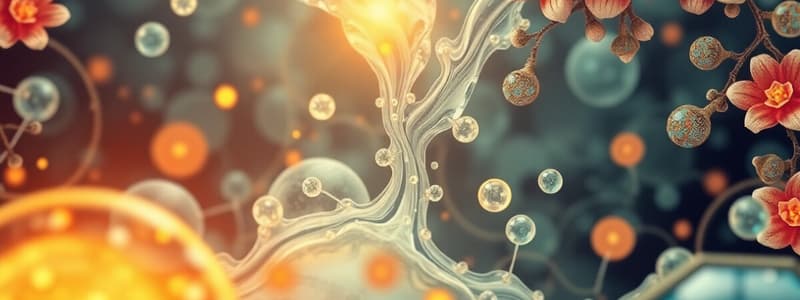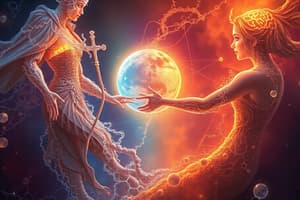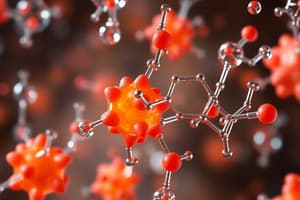Podcast
Questions and Answers
What is the chemical formula for the hydroxide ion?
What is the chemical formula for the hydroxide ion?
- H2O
- H+
- OH- (correct)
- H3O+
What is the pH of a solution that has an equal concentration of H+ and OH- ions?
What is the pH of a solution that has an equal concentration of H+ and OH- ions?
- 14
- 0
- It depends on the specific solution.
- 7 (correct)
Which of the following is a characteristic of a strong acid?
Which of the following is a characteristic of a strong acid?
- It dissociates completely in water. (correct)
- It produces a low concentration of hydrogen ions in solution.
- It has a high pH.
- It is a good proton acceptor.
Which of these is an example of an amphipathic molecule?
Which of these is an example of an amphipathic molecule?
What is the difference in hydrogen ion concentration between a solution with a pH of 3 and a solution with a pH of 5?
What is the difference in hydrogen ion concentration between a solution with a pH of 3 and a solution with a pH of 5?
What is the term for a substance that accepts a proton (H+) when added to a solution?
What is the term for a substance that accepts a proton (H+) when added to a solution?
What is the name given to the ion formed when a water molecule gains an extra hydrogen ion (H+)?
What is the name given to the ion formed when a water molecule gains an extra hydrogen ion (H+)?
Which of these statements accurately describes the relationship between pH and hydrogen ion concentration?
Which of these statements accurately describes the relationship between pH and hydrogen ion concentration?
What is the chemical formula for a compound that is formed from the bonding of one magnesium atom with two chlorine atoms?
What is the chemical formula for a compound that is formed from the bonding of one magnesium atom with two chlorine atoms?
What type of bond is formed when atoms share electrons?
What type of bond is formed when atoms share electrons?
What is the primary function of eicosanoids?
What is the primary function of eicosanoids?
What is the difference between a molecular formula and a structural formula?
What is the difference between a molecular formula and a structural formula?
Which of the following is NOT a class of eicosanoids?
Which of the following is NOT a class of eicosanoids?
Which of the following is a six-carbon monosaccharide?
Which of the following is a six-carbon monosaccharide?
Which of the following is a common disaccharide?
Which of the following is a common disaccharide?
Which of the following best describes an electrolyte imbalance?
Which of the following best describes an electrolyte imbalance?
What is the storage carbohydrate in animals?
What is the storage carbohydrate in animals?
Which of the following best describes the chemical formula for table salt?
Which of the following best describes the chemical formula for table salt?
What is the term for a molecule that has the same chemical formula but a different arrangement of atoms in space?
What is the term for a molecule that has the same chemical formula but a different arrangement of atoms in space?
Which of the following is NOT a fat-soluble vitamin?
Which of the following is NOT a fat-soluble vitamin?
What is the main reason that atoms form bonds?
What is the main reason that atoms form bonds?
Which of the following is NOT a type of steroid?
Which of the following is NOT a type of steroid?
Which of the following is the primary energy source for brain cells?
Which of the following is the primary energy source for brain cells?
What type of bond forms between polar R groups of amino acids?
What type of bond forms between polar R groups of amino acids?
Which secondary structure of a protein is described as having a planar arrangement?
Which secondary structure of a protein is described as having a planar arrangement?
What defines the tertiary structure of a protein?
What defines the tertiary structure of a protein?
Which of the following proteins is an example of quaternary structure?
Which of the following proteins is an example of quaternary structure?
Which type of proteins are characterized by extended linear structures?
Which type of proteins are characterized by extended linear structures?
What is the effect of denaturation on a protein's biological activity?
What is the effect of denaturation on a protein's biological activity?
Which type of bond is specifically formed between cysteine amino acids?
Which type of bond is specifically formed between cysteine amino acids?
What is the primary structural feature that distinguishes proteins from other macromolecules?
What is the primary structural feature that distinguishes proteins from other macromolecules?
What is a prosthetic group in relation to a protein?
What is a prosthetic group in relation to a protein?
Which of the following correctly describes a dipeptide?
Which of the following correctly describes a dipeptide?
Which type of amino acid has side chains that have no charge at physiological pH?
Which type of amino acid has side chains that have no charge at physiological pH?
What is the role of R groups in amino acids?
What is the role of R groups in amino acids?
Which term refers to proteins that are covalently bonded to carbohydrates?
Which term refers to proteins that are covalently bonded to carbohydrates?
What is the result of dehydration synthesis in the context of proteins?
What is the result of dehydration synthesis in the context of proteins?
How many different amino acids are there that can combine to form proteins?
How many different amino acids are there that can combine to form proteins?
What characteristic of proteins is crucial for their functioning?
What characteristic of proteins is crucial for their functioning?
What characterizes polar amino acids?
What characterizes polar amino acids?
Which amino acids are classified as negatively charged?
Which amino acids are classified as negatively charged?
Which statement about cysteine is true?
Which statement about cysteine is true?
How many structural levels does protein conformation have?
How many structural levels does protein conformation have?
What role do chaperone proteins serve in protein synthesis?
What role do chaperone proteins serve in protein synthesis?
What is the primary sequence of a protein?
What is the primary sequence of a protein?
Which of the following interactions is NOT a contributor to protein conformation?
Which of the following interactions is NOT a contributor to protein conformation?
What unique characteristic does proline exhibit?
What unique characteristic does proline exhibit?
Flashcards
Electrolyte Balance
Electrolyte Balance
Maintaining homeostatic blood levels of ions for optimal health.
Electrolyte Imbalance
Electrolyte Imbalance
When blood ion concentrations are too high or too low.
Ionic Bonds
Ionic Bonds
Bond formed by the electrostatic attraction between cations and anions.
Salts
Salts
Signup and view all the flashcards
Cation
Cation
Signup and view all the flashcards
Anion
Anion
Signup and view all the flashcards
Covalent Bond
Covalent Bond
Signup and view all the flashcards
Molecular Compounds
Molecular Compounds
Signup and view all the flashcards
Steroids
Steroids
Signup and view all the flashcards
Eicosanoids
Eicosanoids
Signup and view all the flashcards
Glycolipids
Glycolipids
Signup and view all the flashcards
Fat-soluble vitamins
Fat-soluble vitamins
Signup and view all the flashcards
Monosaccharide
Monosaccharide
Signup and view all the flashcards
Disaccharide
Disaccharide
Signup and view all the flashcards
Polysaccharide
Polysaccharide
Signup and view all the flashcards
Blood glucose homeostasis
Blood glucose homeostasis
Signup and view all the flashcards
Amphipathic molecules
Amphipathic molecules
Signup and view all the flashcards
Hydronium ion (H₃O⁺)
Hydronium ion (H₃O⁺)
Signup and view all the flashcards
Hydroxide ion (OH⁻)
Hydroxide ion (OH⁻)
Signup and view all the flashcards
Acidic solution
Acidic solution
Signup and view all the flashcards
Basic solution
Basic solution
Signup and view all the flashcards
pH scale
pH scale
Signup and view all the flashcards
Strong acid
Strong acid
Signup and view all the flashcards
Neutral solution
Neutral solution
Signup and view all the flashcards
Proteins
Proteins
Signup and view all the flashcards
Amino Acids
Amino Acids
Signup and view all the flashcards
R Groups
R Groups
Signup and view all the flashcards
Peptide Bond
Peptide Bond
Signup and view all the flashcards
Types of Proteins
Types of Proteins
Signup and view all the flashcards
Dipeptide vs. Polypeptide
Dipeptide vs. Polypeptide
Signup and view all the flashcards
Glycoproteins
Glycoproteins
Signup and view all the flashcards
Categories of Amino Acids
Categories of Amino Acids
Signup and view all the flashcards
Polar Amino Acids
Polar Amino Acids
Signup and view all the flashcards
Charged Amino Acids
Charged Amino Acids
Signup and view all the flashcards
Negatively Charged Amino Acids
Negatively Charged Amino Acids
Signup and view all the flashcards
Positively Charged Amino Acids
Positively Charged Amino Acids
Signup and view all the flashcards
Proline
Proline
Signup and view all the flashcards
Cysteine
Cysteine
Signup and view all the flashcards
Methionine
Methionine
Signup and view all the flashcards
Protein Structure Levels
Protein Structure Levels
Signup and view all the flashcards
Hydrogen Bonds
Hydrogen Bonds
Signup and view all the flashcards
Disulfide Bonds
Disulfide Bonds
Signup and view all the flashcards
Secondary Structure
Secondary Structure
Signup and view all the flashcards
Alpha Helix
Alpha Helix
Signup and view all the flashcards
Beta-Pleated Sheet
Beta-Pleated Sheet
Signup and view all the flashcards
Tertiary Structure
Tertiary Structure
Signup and view all the flashcards
Denaturation
Denaturation
Signup and view all the flashcards
Study Notes
Atomic Structure
- Matter is a substance with mass and occupies space.
- Matter exists in solid, liquid, and gas forms.
- All matter is composed of atoms.
- An atom is the smallest particle with the chemical properties of an element.
- There are 92 naturally occurring elements.
- Elements are organized in the periodic table.
- Elements are categorized as major, minor, or trace elements based on their percentage in the human body.
- Major elements comprise ~99% of the human body.
- Atoms are comprised of protons, neutrons, and electrons.
- Protons have a positive charge and a mass of 1 amu.
- Neutrons have no charge and a mass of 1 amu.
- Electrons have a negative charge and are ~1/800th the mass of a proton or neutron.
- Protons and neutrons are located in the atomic nucleus.
- Electrons are found in orbitals or electron shells.
- Each shell has a limited number of electrons it can hold.
- The outermost shell is called the valence shell.
- Isotopes are atoms of the same element with the same number of protons and electrons but different numbers of neutrons.
Isotopes
- Isotopes have essentially identical chemical characteristics.
- Carbon exists in three isotopes: carbon-12, carbon-13, and carbon-14.
- Some isotopes are radioactive (radioisotopes).
Ions and Ionic Compounds
- Ions are atoms or groups of atoms with a positive or negative charge.
- Ions are formed when atoms lose or gain electrons.
- Cations are positively charged ions formed by losing electrons.
- Anions are negatively charged ions formed by gaining electrons.
- Polyatomic ions are ions formed by more than one atom.
- Ionic bonds form through electrostatic interactions between cations and anions.
- Ions function as electrolytes, enabling electrical current in solutions.
Covalent Bonding
- Covalent bonds form when atoms share electrons.
- Molecules are formed when atoms covalently bond.
- Molecular compounds are composed of two or more different elements.
- Covalent bonds can be single, double, or triple.
- Polar covalent bonds occur when electrons are unequally shared.
- Nonpolar covalent bonds occur when electrons are equally shared.
- Electronegativity influences the sharing of electrons.
Polar and Nonpolar Molecules
- Nonpolar molecules form predominantly with the same or same similar elements.
- Polar molecules form from bonding between different elements.
- Intermolecular attractions involve weak chemical attractions between molecules.
- Hydrogen bonds occur between a partially positive hydrogen atom and a partially negative atom (oxygen or nitrogen).
Water Properties
- Water is a polar molecule.
- Water molecules form hydrogen bonds with each other.
- Water's properties include cohesion, adhesion, surface tension, high heat capacity, and high heat of vaporization.
- Water is called the universal solvent.
- Water dissolves polar and charged substances (hydrophilic).
Mixtures
- Water mixtures include suspensions, colloids, and solutions.
- Suspensions have larger particles than 100 nm and settle.
- Colloids have particles between 1 and 100 nanometers and do not settle.
- Solutions have particles smaller than 1 nm and do not settle.
Acidic and Basic Solutions
- Water can dissociate to form hydronium (H3O+) and hydroxide (OH−) ions.
- Acids donate H+, increasing H+ concentration.
- Bases accept H+, decreasing H+ concentration.
- pH measures the concentration of H+ ions.
- Buffers maintain a relatively constant pH.
Studying That Suits You
Use AI to generate personalized quizzes and flashcards to suit your learning preferences.




